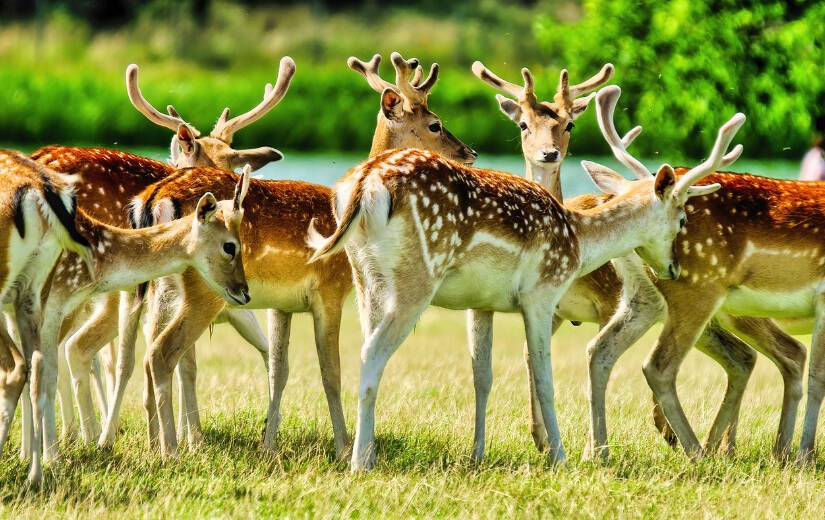A mass kill of fallow deer on Sidney Island is expected to start early Friday morning, despite 11th-hour appeals from those who say the eradication is unnecessary, expensive and inhumane.
Some of the 111 private property owners on the small island have sent letters asking the prime minister and federal environment minister to stop the hunt, while others have appealed to the B.C. SPCA to reverse its stance on the killings.
But First Nations confirmed Wednesday the operation is in progress.
The $6-million plan is aimed at restoring Sidney Island’s fragile Coastal Douglas Fir ecosystems after decades of over-browsing by fallow deer introduced to the island in the 1960s.
A company has been contracted to shoot the deer from a helicopter, aided by hunters on the ground with dogs.
Tsawout hereditary chief Eric Pelkey, head of the W̱SÁNEĆ Leadership Council, said 15 members from five First Nations will set up camps on Thursday in the Gulf Island National Park Reserve at Sidney Spit.
They plan to fan out with all-terrain vehicles to find the carcasses marked by GPS and to do the skinning and butchering.
Pelkey said he understands that some people are angry about the hunt and the way the deer will be killed. Contractor Coastal Conservation had to obtain federal and provincial permits to use restricted weapons and shoot from aircraft and at moving targets.
“Eradication is something that is not popular with our own people and we had to make the case that these fallow deer have caused devastation to the land and the plants and other animals,” Pelkey said. “When our people saw the damage compared to other islands close by [where there are no fallow deer], we agreed. These islands are our healing places.”
A small helicopter carrying a pilot and marksman armed with a semi-automatic rifle is expected to crisscross the island looking for fallow deer, while other hunters use dogs to flush out and kill deer on the ground.
A second phase of killings a year from now will round up the stragglers using fencing and dogs.
Jack and Ruth Albrecht, who have owned a lot on Sidney Island for the past 20 years, wrote to Prime Minister Justin Trudeau and Environment Minister Steven Gilbeault calling for the hunt to be postponed
The Albrechts say fallow deer numbers and the ecological status on the island are not at a critical point. There are no official counts of the number of fallow deer — hunting groups on Sidney Island say there are about 150, while Parks Canada has estimated 300 to 900.
The Island’s strata council voted 52% in favour of the eradication plan earlier this year, but the Albrechts say the vote would likely be much different if taken today, given some of the methods being used in the mass kill.
In an interview, Jack Albrecht said he used to see herds of fallow deer on the island, but now he can spend a week there and not see a single deer.
He said he builds and maintains trails on the common areas, where the “ecology is improving beyond belief … I’m seeing fir and arbutus everywhere.”
In their letter to Trudeau, the Albrechts suggested allocating any money that has not been spent on the project to “First Nations communities most in need of potable water, improved health care and housing — rather than on eradicating several hundred deer on a small, essentially private Gulf Island.”
David Bird, a North Saanich resident who is an avid hunter on Sidney Island and emeritus professor of wildlife biology at McGill University, said an elaborate plan to kill the deer and restore the ecology isn’t necessary.
He said over the past decade, well-organized annual hunts and periodic culls by Island Outfitters have knocked the island’s deer population down from around 2,000 to 2,500 animals to about 300. And he cited a 2019 study by UBC that found vegetation had improved by 30% through ongoing seasonal hunting.
Bird said he was “outraged” when the B.C. SPCA announced last week that it was not opposed to Parks Canada’s plan. The animal welfare group said the mass kill was preferable to the “ineffective killing cycle” of seasonal hunting over decades.
“[The SPCA] are providing the stamp of legitimacy to an inhumane slaughter that does not have widespread public support,” said Bird, noting an online petition against the kill has 20,942 signatures. “My guess is that supporters and donors may well think twice before giving a generous Christmas donation to the B.C. SPCA.”
Meanwhile, Pelkey said the fallow deer meat will be taken to refrigerated trailers and hauled off the island to a butcher who will package the meat for distribution to local First Nations.
He said the fallow deer skins will be used for drums and moccasins and the feet and antlers for ceremonial purposes. After the hunt, blacktail deer will be reintroduced to the island.



